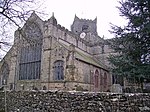Allithwaite
South Lakeland DistrictUse British English from September 2019Villages in Cumbria

Allithwaite is a village in Cumbria, England, located roughly 1.2 miles (1.9 km) west of Grange-over-Sands. Within the boundaries of the historic county of Lancashire, Allithwaite, and the village of Cartmel situated to the north, are part of the civil parish of Lower Allithwaite. At the 2001 census, the parish had a population of 1,758, increasing to 1,831 at the 2011 Census.There is also a civil parish previously known as Upper Allithwaite which was renamed in 2018 as Lindale and Newton-in-Cartmel, and includes Lindale, Low Newton and High Newton. The population of this parish at the 2011 Census was 843.
Excerpt from the Wikipedia article Allithwaite (License: CC BY-SA 3.0, Authors, Images).Allithwaite
The Square,
Geographical coordinates (GPS) Address Nearby Places Show on map
Geographical coordinates (GPS)
| Latitude | Longitude |
|---|---|
| N 54.1802 ° | E -2.9398 ° |
Address
The Square
The Square
LA11 7QF , Lower Allithwaite
England, United Kingdom
Open on Google Maps








